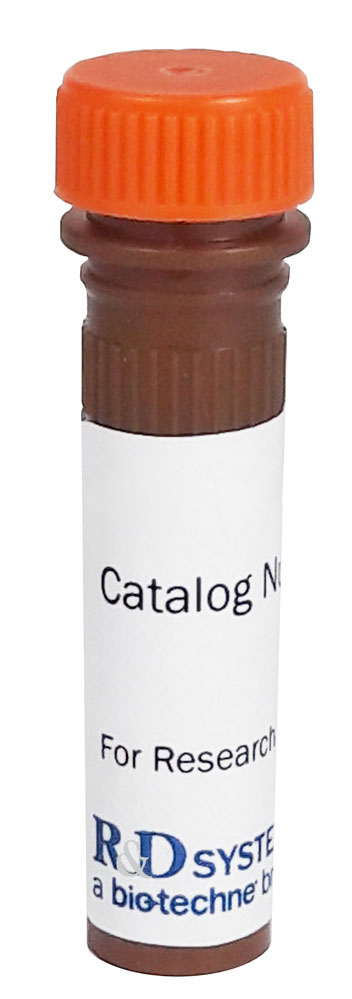Recombinant Mouse Coagulation Factor XIV/Protein C, CF
Recombinant Mouse Coagulation Factor XIV/Protein C, CF Summary
Product Specifications
Ile19-Leu460 (pro) & Ala42-Leu460 (mature), both with a C-terminal 10-His tag
Analysis
Customers also Viewed
Product Datasheets
Carrier Free
CF stands for Carrier Free (CF). We typically add Bovine Serum Albumin (BSA) as a carrier protein to our recombinant proteins. Adding a carrier protein enhances protein stability, increases shelf-life, and allows the recombinant protein to be stored at a more dilute concentration. The carrier free version does not contain BSA.
In general, we advise purchasing the recombinant protein with BSA for use in cell or tissue culture, or as an ELISA standard. In contrast, the carrier free protein is recommended for applications, in which the presence of BSA could interfere.
4885-SE
| Formulation | Supplied as a 0.2 μm filtered solution in Sodium Acetate and NaCl. |
| Shipping | The product is shipped with polar packs. Upon receipt, store it immediately at the temperature recommended below. |
| Stability & Storage: | Use a manual defrost freezer and avoid repeated freeze-thaw cycles.
|
Assay Procedure
- Activation Buffer: 50 mM Tris, 10 mM CaCl2, 150 mM NaCl, 0.05% (w/v) Brij-35, pH 7.5 (TCNB)
- Assay Buffer: 50 mM Tris, 10 mM CaCl2, 150 mM NaCl, 0.01% (w/v) Brij-35, pH 8.5
- Recombinant Mouse Coagulation Factor XIV/Protein C (rmPROC) (Catalog # 4885-SE)
- Bacterial Thermolysin (Thermolysin) (Catalog # 3097-ZN)
- 1,10 phenanthroline (Sigma, Catalog # 320056), 0.6 M stock in DMSO
- Substrate: BOC-beta -benzyl-Asp-Pro-Arg-AMC (Bachem, Catalog # I-1560), 10 mM in DMSO
- F16 Black Maxisorp Plate (Nunc, Catalog # 475515)
- Fluorescent Plate Reader (Model: SpectraMax Gemini EM by Molecular Devices) or equivalent
- Dilute rmPROC to 200 µg/mL in Activation Buffer.
- Dilute Thermolysin to 10 µg/mL in Activation Buffer.
- Combine 25 µL of the diluted rmPROC and 25 µL of the diluted Thermolysin.
- Incubate at 37 °C for 2 hours.
- Dilute 1,10 phenanthroline to 5 mM in Assay Buffer.
- Add 200 µL of 5 mM 1,10 phenanthroline to the reaction mixtures to stop the Thermolysin activation.
- Dilute rmPROC to 2 µg/mL in Assay Buffer.
- Dilute Substrate to 200 µM in Assay Buffer.
- Load 50 µL of 2 µg/mL rmPROC into a plate, and start the reaction by adding 50 µL of 200 µM Substrate.
- Include a Substrate Blank containing 50 µL Assay Buffer and 50 µL of 200 µM Substrate.
- Read at excitation and emission wavelengths of 380 nm and 460 nm (top read), respectively, in kinetic mode for 5 minutes.
- Calculate specific activity:
|
Specific Activity (pmol/min/µg) = |
Adjusted Vmax* (RFU/min) x Conversion Factor** (pmol/RFU) |
| amount of enzyme (µg) |
*Adjusted for Substrate Blank
**Derived using calibration standard 7-Amino, 4-Methyl Coumarin (AMC) (Sigma, Catalog # A-9891).
- rmPROC: 0.100 µg
- Substrate: 100 µM
Background: Coagulation Factor XIV/Protein C
Protein C is a vitamin K-dependent serine protease synthesized in the liver as a single-chain precursor, which is then proteolytically processed to two disulfide-linked chains (1). The light chain consists of a Gla (gamma-carboxy-glutamate) domain and two EGF-like domains. The heavy chain consists of an activation peptide (aa 199‑212) and serine protease domain (aa 213‑449). Physiologically, Protein C is converted to the active form by thrombin, which releases the activation peptide. Protein C plays a key role in anticoagulation, cleaving factors VIIIa and Va to inactivate them. This anticoagulation activity can be enhanced by a presence of a cofactor such as protein S. In hereditary thrombophilia, Protein C deficiency is caused by a genetic mutation that affects Protein C activity. A severe recessive form may result in massive thrombosis fatal to patient.
- Shen, L. and Dahlbäck, B. (2004) in Handbook of Proteolytic Enzymes, Barrett, A.J. et al. eds. pp. 1673.
FAQs
No product specific FAQs exist for this product, however you may
View all Proteins and Enzyme FAQsNatural Enzymes
Reviews for Recombinant Mouse Coagulation Factor XIV/Protein C, CF
There are currently no reviews for this product. Be the first to review Recombinant Mouse Coagulation Factor XIV/Protein C, CF and earn rewards!
Have you used Recombinant Mouse Coagulation Factor XIV/Protein C, CF?
Submit a review and receive an Amazon gift card.
$25/€18/£15/$25CAN/¥75 Yuan/¥2500 Yen for a review with an image
$10/€7/£6/$10 CAD/¥70 Yuan/¥1110 Yen for a review without an image





